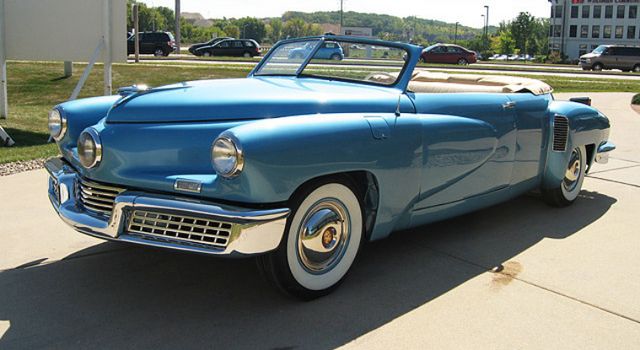
The One And Only Tucker Convertible Is For Sale-But Is It Real?
Most people believe what they hear or what they read unless they dig a little. Once you start digging many times you find the truth. Then you wonder why certain “facts” that are easy to disprove continue to be asserted by those with something to gain. Such is the case with the one and only Tucker ‘vert. If you’re not familiar with the Tucker automobile go watch the movie “Tucker: The Man And His Dream” to find out more. Disclosure: I did some art used in the movie for Art Director Alex Tavoularis.
There existed 51 Tuckers but none were convertibles

There were 30+ Tucker prototypes built before shutting down. Workers snuck into the factory after it was closed and completed another 15 or so for a grand total of 51. Some were not completely complete when they were sold at auction. Eventually, especially as values started spiking, all of the Tuckers were finished. One was destroyed in a track testing mishap. Today 47 Tucker automobiles remain.
But there were also pieces that roved around from collector to collector over the next several decades. Eventually, enough pieces were gathered to make what is reputed to be a Tucker convertible prototype. The story goes that it was started at the factory before things were shut down, and never completed. While it’s true that pieces floated through the air, these pieces never existed as a convertible prototype. And though a convertible was probably one of Preston Tucker’s dreams, he had a company to keep from drowning and didn’t have the luxury of doing what-ifs.
The only factory variation of a Tucker sedan had an experimental wrapping rear window

The only variation of the Tucker sedan that was explored was one body found that had a wrapping rear window. It was body number 57. As best as we can tell, it was sold as scrap and has never been found. But the cowl of the convertible has a stamped number on it. It is “57.”
That’s what was unusual about the pieces that went into building the convertible. Most of them were all, real, genuine Tucker pieces. Some parts, like the convertible top, came from other makes. In this case, an Oldsmobile convertible gave up its top irons for the cause. But that really doesn’t matter. Putting them all together makes it a valuable, expensive vehicle, regardless of the provenance behind it.
Making a two-door convertible out of Tucker pieces is quite the accomplishment

So making a two-door convertible out of what was left of scrap Tucker pieces is quite an accomplishment. It in no way diminishes what it is; a real Tucker automobile. So the idea that a story about being a real Tucker prototype is kind of lame. And the supporting documentation and interviews to back it up have so many holes, you wonder why it continues to be used.
But here we are in 2020, and those ridiculous stories about this being started before the factory closed on orders from Preston himself, are not real if you dig a little. And when you try to get verification from avid Tucker experts, they tend to either talk around the fact the story is not true, or they passionately, vehemently, deny that it is true. No one says it is true, however.
Barrett-Jackson described it as a “rare original Tucker that has been customized into a convertible”
One of the times it came up for sale was back in 2013, with Barrett-Jackson. Its description was a “rare original Tucker that has been customized into a convertible.” It knew that misrepresenting the car could land them in a heavy lawsuit, and wrote the appropriate catalog description to indemnify themselves. The car was eventually pulled by its owner before the auction.
Before the Barrett-Jackson auction in 2013, the Tucker was consigned to Russo and Steele in 2010. At that auction, it was a no-sale at $1.4 million, as it failed to meet the reserve which was just under $4 million.

We know all of this because years ago when the car first surfaced, I was consigned to do an article about the car. When the supporting evidence was finally revealed, it just didn’t line up. So I contacted a number of Tucker experts who were easy to find and easier to get the facts from. I was even able to track down the last owner of the pieces before he sold them off to become the Tucker convertible. It was sketchy enough that I ended up passing on the story.
A made-up story behind a real Tucker is unnecessary
But, let’s be clear. Any Tucker is worth big money. And in the case of this particular Tucker, the story behind its existence is not necessary to make it a real Tucker. It’s just that it is not a real prototype that was started before the company shut its doors. And it seems a shame that the current owner or owners feel the need to perpetuate the story.
It’s a beautiful car, a one-off, a real Tucker, and worth its weight in gold. That’s all the next buyer needs to know. And it’s what the world of car collectors should focus on, rather than the narrative that goes along with it every time it comes up for sale, which has been a few times as best as we remember. Caveat emptor!



